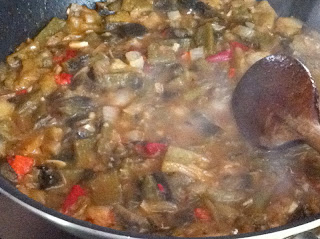Tartare has been one of my favorite dishes for many years. On our last visit to France (2 week in duration), I ordered it 5 times when we went out to eat. On the last occasion my wife said "you're having tartare again!?!"
How could I pass it up? More often than not, restaurants in the states do not have it on the menu. And this one had a slice of foie gras torchon AND black truffle!
These were steak tartare, usually filet mignon diced into small cubes that is served raw with some accompaniments.
There are other meats that lend themselves well to this preparation and today's blog is about one of those.
Some here is the real story of today's blog:
My daughter has a thing for tartare and for her birthday asked for steak tartare as one of the courses of the meal that the family would have during that meal. I have an aversion to buying filet mignon for I find it ridiculously over priced. It is one of my least favorite cuts of beef for any other purpose than tartare as it needs a sauce of else I find it boring in any other preparation.
My wife and I discussed what to do and decided to make Ahi Tuna Tartare for the meal. This was a dish that was very popular at the restaurant that we owned and also one of my daughters favorite types of fish as she absolutely adores Maguro when we have sushi.
We also have a great fish monger in the neighborhood who has very fresh product, so the decision was easy.
At the fish mongers', he had some beautiful sashimi grade ahi, so I bought a large loin piece, maybe 1.75 lbs (.78 kg).
The recipe for this is really more of a "to taste" sort of preparation, so I'll give you some guidelines to follow when making this. The idea here is to play and make it what you want it to be, there really is no right or wrong.
I trimmed the ahi so that I had removed the blood line. The blood line is the very dark red part of the cut that is unpleasant to eat, just tastes like blood. I don't find it good raw or cooked.
Next I cut away the center of the loin.
This is the part that will be the tartare, leaving the tougher section and skin.
I remove the skin and reserve the tougher portion. This part is very good seared or grilled. My son will not eat raw tuna, so this will be his for my daughters' birthday dinner.
Next, cut the tuna in 1/4" slices.
Cut those into strips of the same thickness.
Next make the meat into small cubes. Refrigerate.
It is important that tartare in any form is kept as cold as you can keep it. First, it has a better "mouth feel" cold and second, it is wise to keep all of your raw meats cold when working with them. More so when you plan to consume it raw as well. I'm not the type of person that is afraid of my food, but why take any chances anyway?
In the restaurant, I served our tartare with habanero oil, thinly sliced scallions, onion sprouts and really long crustini that was cut from a baguette and drizzled with basil oil. This was served in a large martini glass. It was both beautiful and dramatic.
My daughter does not like spicy things, so today I will make a special recipe for her.
I chose to follow a very simple route and let the ingredients speak for themselves.
I added kosher salt, fresh black pepper and a mild extra virgin olive oil (EVOO). A strong EVOO would overpower the delicate flavor of the fish so I decided against our more robust EVOO.
Once I was satisfied with the flavor, I covered the bowl of tuna and returned to to the refrigerator.
My wife wanted to reveal the tartare on some fun black glass plates that she inherited from her grand mother. I was not so sure that the presentation would be right. Turns out it was a good idea, it looked fantastic!
Usually I use a ring mold to present tartare, but today we used some really cool spoons and forks that we purchased in Sweden several years ago. The idea was to have the tartare spilling over the spoon onto the plate. The effect worked. What a lovely meal!

































